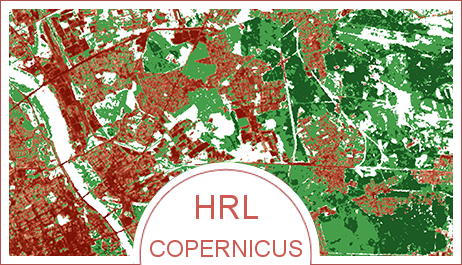The standard CLC nomenclature includes 44 land cover classes. These are grouped in a three-level hierarchy. The five main (level 1) categories are: 1) artificial surfaces, 2) agricultural areas, 3) forests and semi-natural areas, 4) wetlands, and 5) water bodies (Heymann et al., 1994). At level 2 fifteen types of land cover were distinguished, which can be presented on the maps at scales from 1:500 000 to 1:1 000 000. At level 3, 44 land cover classes were distinguished. All national teams adopted this standard nomenclature. In Poland 31 classes out of 44 classes are present. Although the 44 categories have not changed since the implementation of the first CLC inventory (1986–1998), the definitions of most of the nomenclature elements have been improved.
CORINE LAND COVER LEGEND
| Level 1 | Level 2 | Level 3 | Grid_Code | RGB |
|---|---|---|---|---|
| 1. ARTIFICIAL SURFACES | 1.1 Urban fabric | 1.1.1 Continuous urban fabric | 1 | 230-000-077 |
| 1.1.2 Discontinuous urban fabric | 2 | 255-000-000 | ||
| 1.2 Industrial, commercial and transport units | 1.2.1 Industrial or commercial units | 3 | 204-077-242 | |
| 1.2.2 Road and rail networks and associated land | 4 | 204-000-000 | ||
| 1.2.3 Port areas | 5 | 230-204-204 | ||
| 1.2.4 Airports | 6 | 230-204-230 | ||
| 1.3 Mine, dump and construction sites | 1.3.1 Mineral extraction sites | 7 | 166-000-204 | |
| 1.3.2 Dump sites | 8 | 166-077-000 | ||
| 1.3.3 Construction sites | 9 | 255-077-255 | ||
| 1.4 Artificial, non-agricultural vegetated areas | 1.4.1 Green urban areas | 10 | 255-166-255 | |
| 1.4.2 Sport and leisure facilities | 11 | 255-230-255 | ||
| 2. AGRICULTURAL AREAS | 2.1 Arable land | 2.1.1 Non-irrigated arable land | 12 | 255-255-168 |
| 2.1.2 Permanently irrigated land | 13 | 255-255-000 | ||
| 2.1.3 Rice fields | 14 | 230-230-000 | ||
| 2.2 Permanent crops | 2.2.1 Vineyards | 15 | 230-128-000 | |
| 2.2.2 Fruit trees and berry plantations | 16 | 242-166-077 | ||
| 2.2.3 Olive groves | 17 | 230-166-000 | ||
| 2.3 Pastures | 2.3.1 Pastures | 18 | 230-230-077 | |
| 2.4 Heterogeneous agricultural areas | 2.4.1 Annual crops associated with permanent crops | 19 | 255-230-166 | |
| 2.4.2 Complex cultivation patterns | 20 | 255-230-077 | ||
| 2.4.3 Land principally occupied by agriculture, with significant areas of natural vegetation |
21 | 230-204-077 | ||
| 2.4.4 Agro-forestry areas | 22 | 242-204-166 | ||
| 3. FOREST AND SEMI NATURAL AREAS | 3.1 Forests | 3.1.1 Broad-leaved forest | 23 | 128-255-000 |
| 3.1.2 Coniferous forest | 24 | 000-166-000 | ||
| 3.1.3 Mixed forest | 25 | 077-255-000 | ||
| 3.2 Scrub and/or herbaceous vegetation associations |
3.2.1 Natural grasslands | 26 | 204-242-077 | |
| 3.2.2 Moors and heathland | 27 | 166-255-128 | ||
| 3.2.3 Sclerophyllous vegetation | 28 | 166-230-077 | ||
| 3.2.4 Transitional woodland-shrub | 29 | 166-242-000 | ||
| 3.3 Open spaces with little or no vegetation | 3.3.1 Beaches, dunes, sands | 30 | 230-230-230 | |
| 3.3.2 Bare rocks | 31 | 204-204-204 | ||
| 3.3.3 Sparsely vegetated areas | 32 | 204-255-204 | ||
| 3.3.4 Burnt areas | 33 | 000-000-000 | ||
| 3.3.5 Glaciers and perpetual snow | 34 | 166-230-204 | ||
| 4. WETLANDS | 4.1 Inland wetlands | 4.1.1 Inland marshes | 35 | 166-166-255 |
| 4.1.2 Peat bogs | 36 | 077-077-255 | ||
| 4.2 Maritime wetlands | 4.2.1 Salt marshes | 37 | 204-204-255 | |
| 4.2.2 Salines | 38 | 230-230-255 | ||
| 4.2.3 Intertidal flats | 39 | 166-166-230 | ||
| 5. WATER BODIES | 5.1 Inland waters | 5.1.1 Water courses | 40 | 000-204-242 |
| 5.1.2 Water bodies | 41 | 128-242-230 | ||
| 5.2 Marine waters | 5.2.1 Coastal lagoons | 42 | 000-255-166 | |
| 5.2.2 Estuaries | 43 | 166-255-230 | ||
| 5.2.3 Sea and ocean | 44 | 230-242-255 | ||
| No Data | No Data | 48 | ||
| No Data | 49 | |||
| No Data | 50 | 230-242-255 |




















